Travel and Tourism Industry: Analysis of Trends, Factors, and Behavior
VerifiedAdded on 2020/10/22
|14
|4449
|166
Report
AI Summary
This report provides a comprehensive overview of the contemporary travel and tourism industry. It begins with an introduction to the industry's rapid development and its various elements, including attraction, transportation, hospitality, and organizational sectors. The report then delves into factors affecting tourism behavior, such as the global economy, internet and social media, and personal budgets, and explores models of motivation influencing consumer decision-making, differentiating between internal and external factors. The report further examines the link between key drivers of tourist behavior and destination popularity, highlighting the impact of online reviews and economic conditions. Finally, the report discusses the influence of various factors on the popularity of global destinations. The report provides a detailed analysis of the current state and future prospects of the travel and tourism industry.
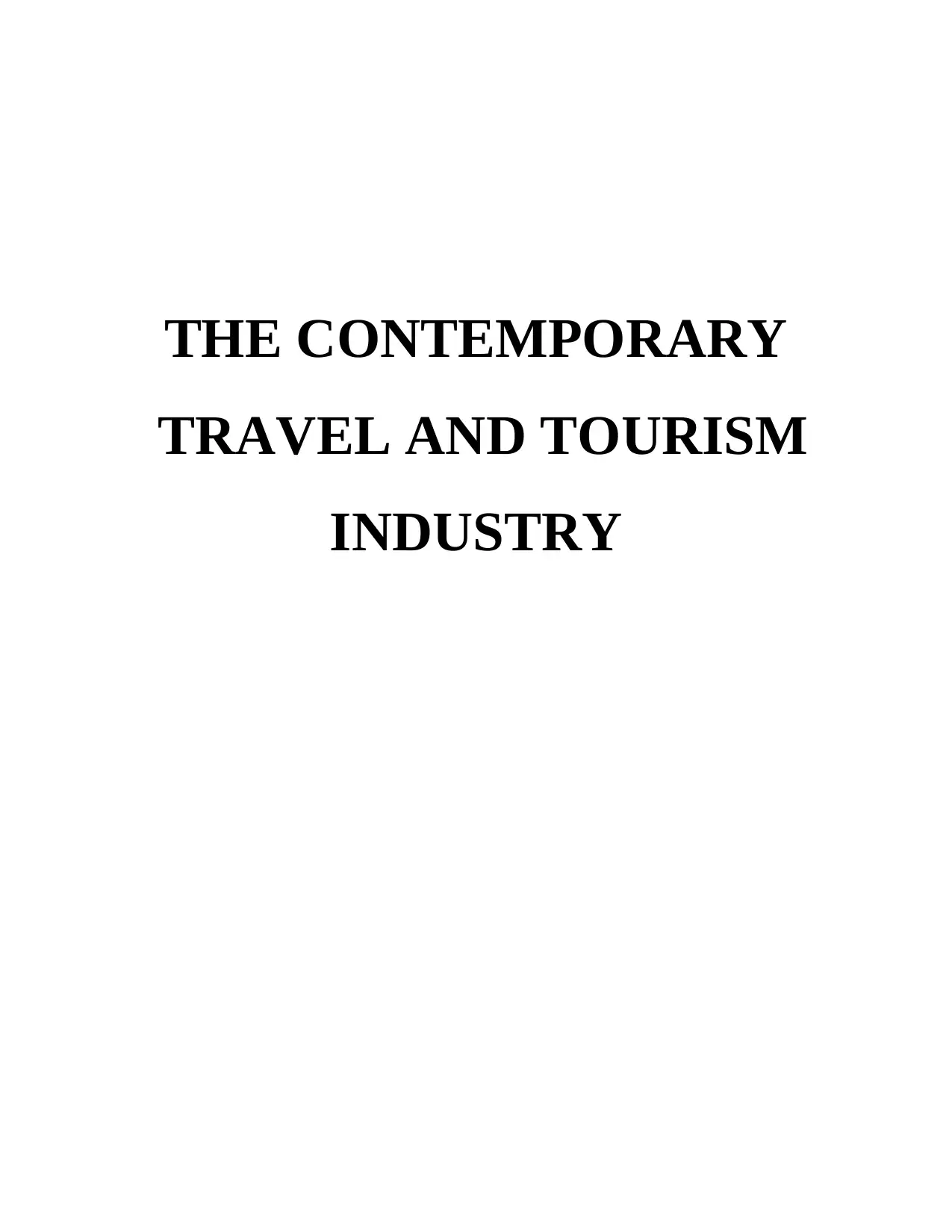
THE CONTEMPORARY
TRAVEL AND TOURISM
INDUSTRY
TRAVEL AND TOURISM
INDUSTRY
Paraphrase This Document
Need a fresh take? Get an instant paraphrase of this document with our AI Paraphraser
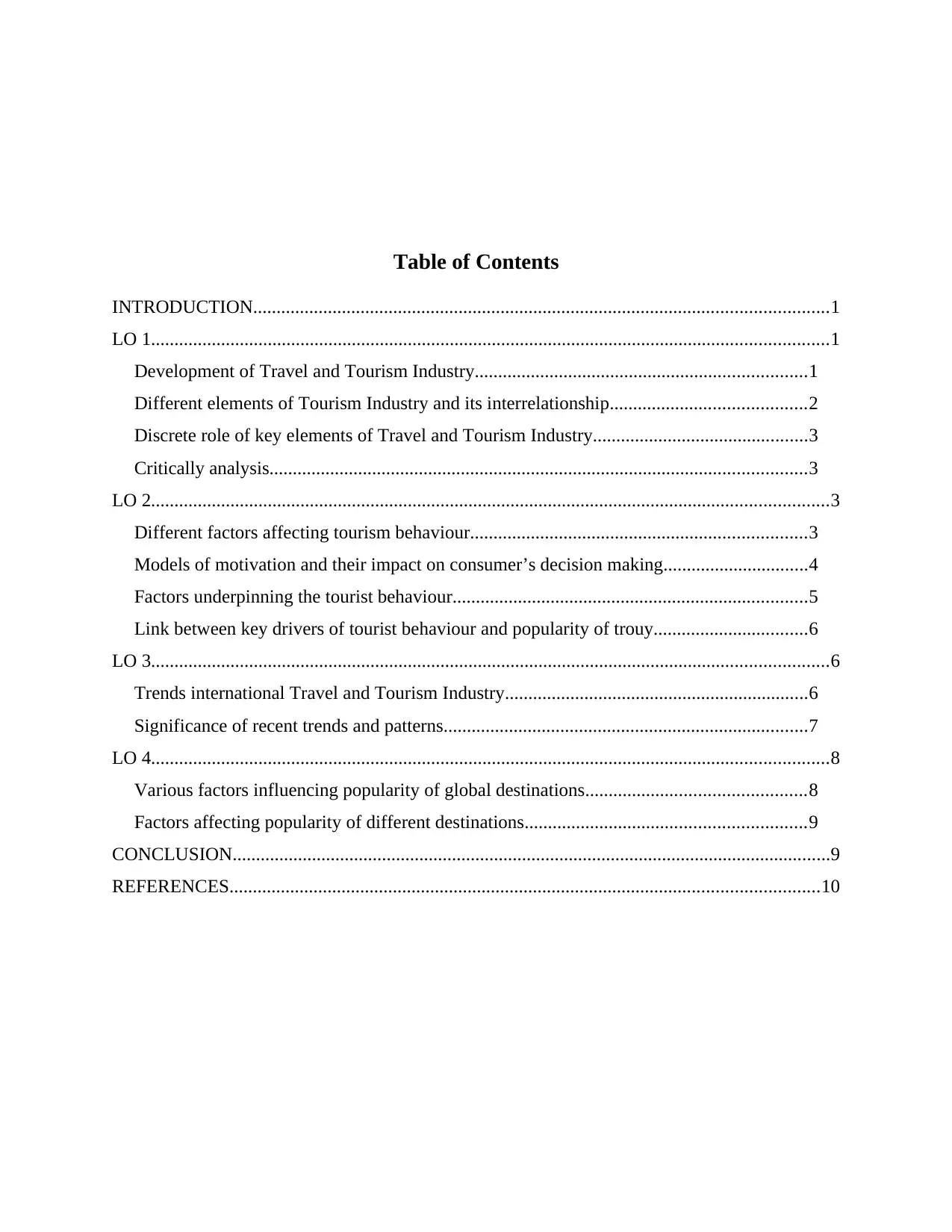
Table of Contents
INTRODUCTION...........................................................................................................................1
LO 1.................................................................................................................................................1
Development of Travel and Tourism Industry.......................................................................1
Different elements of Tourism Industry and its interrelationship..........................................2
Discrete role of key elements of Travel and Tourism Industry..............................................3
Critically analysis...................................................................................................................3
LO 2.................................................................................................................................................3
Different factors affecting tourism behaviour........................................................................3
Models of motivation and their impact on consumer’s decision making...............................4
Factors underpinning the tourist behaviour............................................................................5
Link between key drivers of tourist behaviour and popularity of trouy.................................6
LO 3.................................................................................................................................................6
Trends international Travel and Tourism Industry.................................................................6
Significance of recent trends and patterns..............................................................................7
LO 4.................................................................................................................................................8
Various factors influencing popularity of global destinations...............................................8
Factors affecting popularity of different destinations............................................................9
CONCLUSION................................................................................................................................9
REFERENCES..............................................................................................................................10
INTRODUCTION...........................................................................................................................1
LO 1.................................................................................................................................................1
Development of Travel and Tourism Industry.......................................................................1
Different elements of Tourism Industry and its interrelationship..........................................2
Discrete role of key elements of Travel and Tourism Industry..............................................3
Critically analysis...................................................................................................................3
LO 2.................................................................................................................................................3
Different factors affecting tourism behaviour........................................................................3
Models of motivation and their impact on consumer’s decision making...............................4
Factors underpinning the tourist behaviour............................................................................5
Link between key drivers of tourist behaviour and popularity of trouy.................................6
LO 3.................................................................................................................................................6
Trends international Travel and Tourism Industry.................................................................6
Significance of recent trends and patterns..............................................................................7
LO 4.................................................................................................................................................8
Various factors influencing popularity of global destinations...............................................8
Factors affecting popularity of different destinations............................................................9
CONCLUSION................................................................................................................................9
REFERENCES..............................................................................................................................10

⊘ This is a preview!⊘
Do you want full access?
Subscribe today to unlock all pages.

Trusted by 1+ million students worldwide

INTRODUCTION
Tourism sector is considered as the one of the fastest & biggest developing industry
around the world-wide. Tourism comprises of different activities of people who are travelling to
and staying in different places outside of their regular environment. The purpose of travelling
can be business, leisure or some other purposes. UNWTO is the United Nations specialized
agency that is responsible for promoting the responsibility, sustainability and universally
accessible travel and tourism. In the present report, development of travel and tourism industry is
discussed in brief and also the different elements of industry that provides tourism experience.
Different approaches or models for motivating people are discussed in the report that helps in
influencing the consumer's decision-making. Further the report examines various features that
affects the popularity of different global destinations.
LO 1
Development of Travel and Tourism Industry
Travel and tourism industry is developing and growing on rapid rate and speed. The
development in travel and tourism industry is happening with the change in human behaviour
and also their expectations. Since 1945, the growth and development in the travel and tourism
industry was seen (Sharpley, 2018). People tends to travel to diverse places and destinations and
these changing behaviours of people has led to make the development of the industry. At the
beginning of growth of travel and tourism, it included travelling and transfer of goods and
services. Now-a-days, it includes travelling and those areas that are additional to the client's ease.
There are various factors which came into existence from 1960s, such as, inclined client's interest
for long trips, increasing free time availabilities, per capital income growth, tour package
improvements and many more.
Formation of travel and tourism industry gets highly affected through various industries
which are established in those segments (Benckendorff, Xiang and Sheldon, 2019). The new
entrants of travel and tourism industry aims at offering great offers and packages for trips and
tours that are customer-oriented for increasing the market opportunities. Every business
organisation in travel and tourism industry focuses on adopting and implementing different
strategies in order to increase the market share. Different businesses provides travelling services
1
Tourism sector is considered as the one of the fastest & biggest developing industry
around the world-wide. Tourism comprises of different activities of people who are travelling to
and staying in different places outside of their regular environment. The purpose of travelling
can be business, leisure or some other purposes. UNWTO is the United Nations specialized
agency that is responsible for promoting the responsibility, sustainability and universally
accessible travel and tourism. In the present report, development of travel and tourism industry is
discussed in brief and also the different elements of industry that provides tourism experience.
Different approaches or models for motivating people are discussed in the report that helps in
influencing the consumer's decision-making. Further the report examines various features that
affects the popularity of different global destinations.
LO 1
Development of Travel and Tourism Industry
Travel and tourism industry is developing and growing on rapid rate and speed. The
development in travel and tourism industry is happening with the change in human behaviour
and also their expectations. Since 1945, the growth and development in the travel and tourism
industry was seen (Sharpley, 2018). People tends to travel to diverse places and destinations and
these changing behaviours of people has led to make the development of the industry. At the
beginning of growth of travel and tourism, it included travelling and transfer of goods and
services. Now-a-days, it includes travelling and those areas that are additional to the client's ease.
There are various factors which came into existence from 1960s, such as, inclined client's interest
for long trips, increasing free time availabilities, per capital income growth, tour package
improvements and many more.
Formation of travel and tourism industry gets highly affected through various industries
which are established in those segments (Benckendorff, Xiang and Sheldon, 2019). The new
entrants of travel and tourism industry aims at offering great offers and packages for trips and
tours that are customer-oriented for increasing the market opportunities. Every business
organisation in travel and tourism industry focuses on adopting and implementing different
strategies in order to increase the market share. Different businesses provides travelling services
1
Paraphrase This Document
Need a fresh take? Get an instant paraphrase of this document with our AI Paraphraser
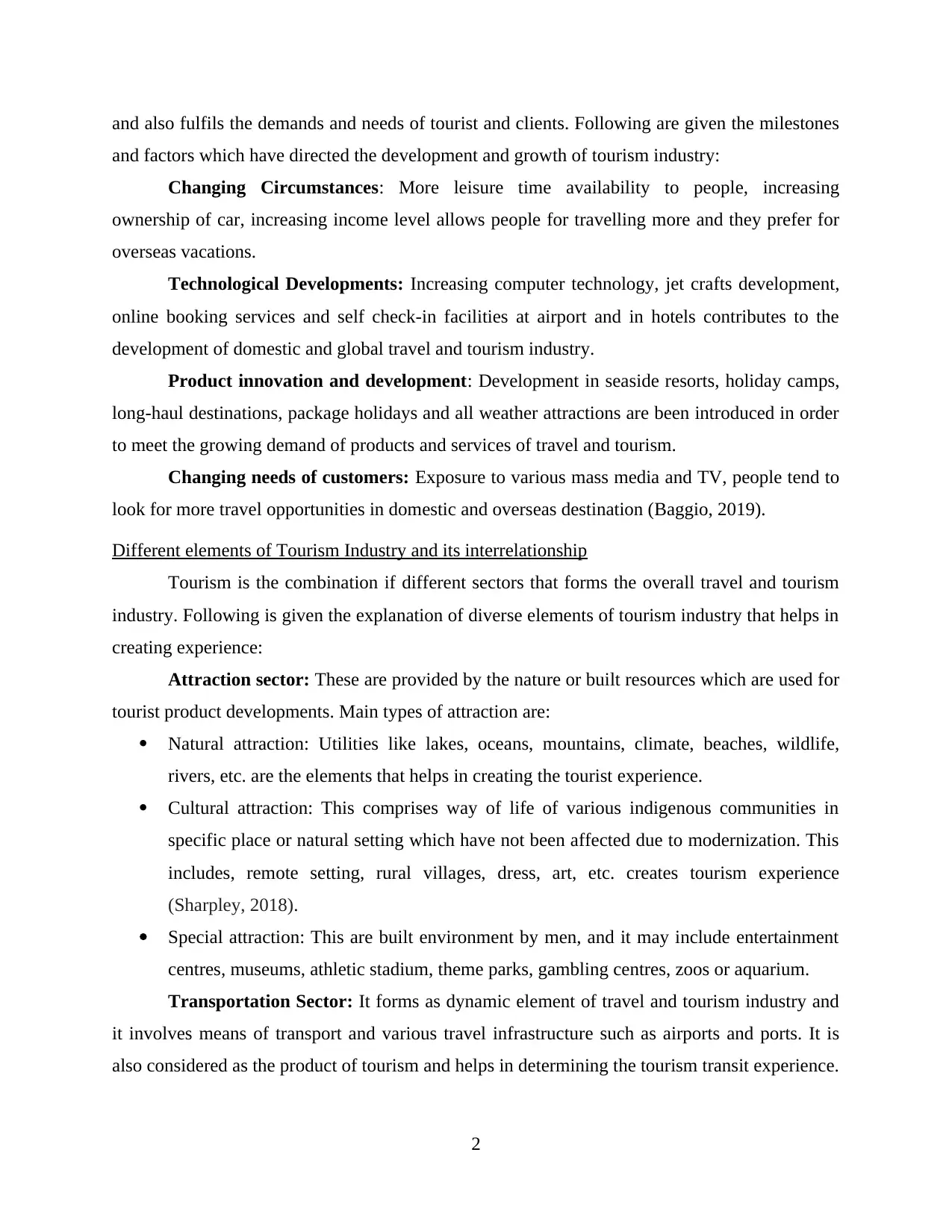
and also fulfils the demands and needs of tourist and clients. Following are given the milestones
and factors which have directed the development and growth of tourism industry:
Changing Circumstances: More leisure time availability to people, increasing
ownership of car, increasing income level allows people for travelling more and they prefer for
overseas vacations.
Technological Developments: Increasing computer technology, jet crafts development,
online booking services and self check-in facilities at airport and in hotels contributes to the
development of domestic and global travel and tourism industry.
Product innovation and development: Development in seaside resorts, holiday camps,
long-haul destinations, package holidays and all weather attractions are been introduced in order
to meet the growing demand of products and services of travel and tourism.
Changing needs of customers: Exposure to various mass media and TV, people tend to
look for more travel opportunities in domestic and overseas destination (Baggio, 2019).
Different elements of Tourism Industry and its interrelationship
Tourism is the combination if different sectors that forms the overall travel and tourism
industry. Following is given the explanation of diverse elements of tourism industry that helps in
creating experience:
Attraction sector: These are provided by the nature or built resources which are used for
tourist product developments. Main types of attraction are:
Natural attraction: Utilities like lakes, oceans, mountains, climate, beaches, wildlife,
rivers, etc. are the elements that helps in creating the tourist experience.
Cultural attraction: This comprises way of life of various indigenous communities in
specific place or natural setting which have not been affected due to modernization. This
includes, remote setting, rural villages, dress, art, etc. creates tourism experience
(Sharpley, 2018).
Special attraction: This are built environment by men, and it may include entertainment
centres, museums, athletic stadium, theme parks, gambling centres, zoos or aquarium.
Transportation Sector: It forms as dynamic element of travel and tourism industry and
it involves means of transport and various travel infrastructure such as airports and ports. It is
also considered as the product of tourism and helps in determining the tourism transit experience.
2
and factors which have directed the development and growth of tourism industry:
Changing Circumstances: More leisure time availability to people, increasing
ownership of car, increasing income level allows people for travelling more and they prefer for
overseas vacations.
Technological Developments: Increasing computer technology, jet crafts development,
online booking services and self check-in facilities at airport and in hotels contributes to the
development of domestic and global travel and tourism industry.
Product innovation and development: Development in seaside resorts, holiday camps,
long-haul destinations, package holidays and all weather attractions are been introduced in order
to meet the growing demand of products and services of travel and tourism.
Changing needs of customers: Exposure to various mass media and TV, people tend to
look for more travel opportunities in domestic and overseas destination (Baggio, 2019).
Different elements of Tourism Industry and its interrelationship
Tourism is the combination if different sectors that forms the overall travel and tourism
industry. Following is given the explanation of diverse elements of tourism industry that helps in
creating experience:
Attraction sector: These are provided by the nature or built resources which are used for
tourist product developments. Main types of attraction are:
Natural attraction: Utilities like lakes, oceans, mountains, climate, beaches, wildlife,
rivers, etc. are the elements that helps in creating the tourist experience.
Cultural attraction: This comprises way of life of various indigenous communities in
specific place or natural setting which have not been affected due to modernization. This
includes, remote setting, rural villages, dress, art, etc. creates tourism experience
(Sharpley, 2018).
Special attraction: This are built environment by men, and it may include entertainment
centres, museums, athletic stadium, theme parks, gambling centres, zoos or aquarium.
Transportation Sector: It forms as dynamic element of travel and tourism industry and
it involves means of transport and various travel infrastructure such as airports and ports. It is
also considered as the product of tourism and helps in determining the tourism transit experience.
2
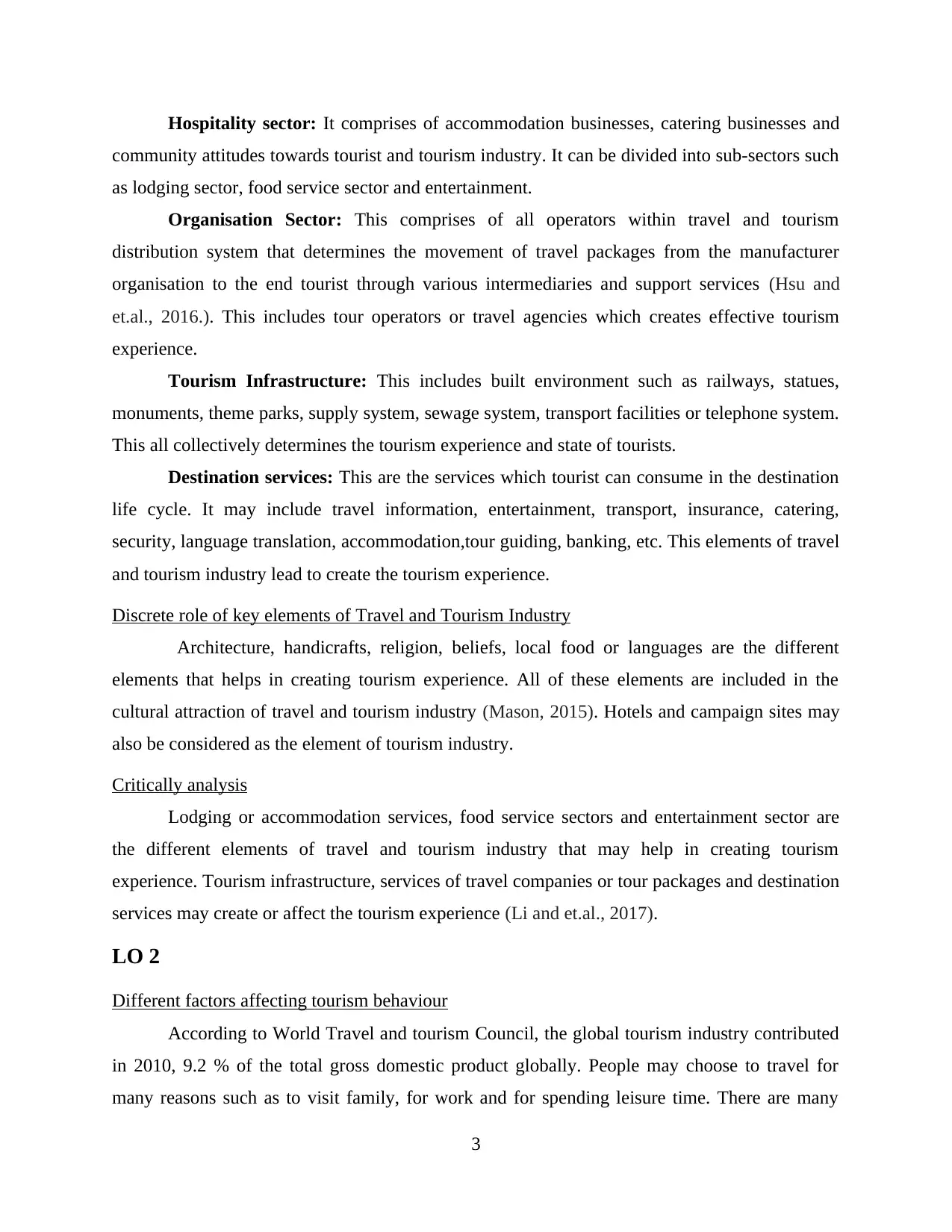
Hospitality sector: It comprises of accommodation businesses, catering businesses and
community attitudes towards tourist and tourism industry. It can be divided into sub-sectors such
as lodging sector, food service sector and entertainment.
Organisation Sector: This comprises of all operators within travel and tourism
distribution system that determines the movement of travel packages from the manufacturer
organisation to the end tourist through various intermediaries and support services (Hsu and
et.al., 2016.). This includes tour operators or travel agencies which creates effective tourism
experience.
Tourism Infrastructure: This includes built environment such as railways, statues,
monuments, theme parks, supply system, sewage system, transport facilities or telephone system.
This all collectively determines the tourism experience and state of tourists.
Destination services: This are the services which tourist can consume in the destination
life cycle. It may include travel information, entertainment, transport, insurance, catering,
security, language translation, accommodation,tour guiding, banking, etc. This elements of travel
and tourism industry lead to create the tourism experience.
Discrete role of key elements of Travel and Tourism Industry
Architecture, handicrafts, religion, beliefs, local food or languages are the different
elements that helps in creating tourism experience. All of these elements are included in the
cultural attraction of travel and tourism industry (Mason, 2015). Hotels and campaign sites may
also be considered as the element of tourism industry.
Critically analysis
Lodging or accommodation services, food service sectors and entertainment sector are
the different elements of travel and tourism industry that may help in creating tourism
experience. Tourism infrastructure, services of travel companies or tour packages and destination
services may create or affect the tourism experience (Li and et.al., 2017).
LO 2
Different factors affecting tourism behaviour
According to World Travel and tourism Council, the global tourism industry contributed
in 2010, 9.2 % of the total gross domestic product globally. People may choose to travel for
many reasons such as to visit family, for work and for spending leisure time. There are many
3
community attitudes towards tourist and tourism industry. It can be divided into sub-sectors such
as lodging sector, food service sector and entertainment.
Organisation Sector: This comprises of all operators within travel and tourism
distribution system that determines the movement of travel packages from the manufacturer
organisation to the end tourist through various intermediaries and support services (Hsu and
et.al., 2016.). This includes tour operators or travel agencies which creates effective tourism
experience.
Tourism Infrastructure: This includes built environment such as railways, statues,
monuments, theme parks, supply system, sewage system, transport facilities or telephone system.
This all collectively determines the tourism experience and state of tourists.
Destination services: This are the services which tourist can consume in the destination
life cycle. It may include travel information, entertainment, transport, insurance, catering,
security, language translation, accommodation,tour guiding, banking, etc. This elements of travel
and tourism industry lead to create the tourism experience.
Discrete role of key elements of Travel and Tourism Industry
Architecture, handicrafts, religion, beliefs, local food or languages are the different
elements that helps in creating tourism experience. All of these elements are included in the
cultural attraction of travel and tourism industry (Mason, 2015). Hotels and campaign sites may
also be considered as the element of tourism industry.
Critically analysis
Lodging or accommodation services, food service sectors and entertainment sector are
the different elements of travel and tourism industry that may help in creating tourism
experience. Tourism infrastructure, services of travel companies or tour packages and destination
services may create or affect the tourism experience (Li and et.al., 2017).
LO 2
Different factors affecting tourism behaviour
According to World Travel and tourism Council, the global tourism industry contributed
in 2010, 9.2 % of the total gross domestic product globally. People may choose to travel for
many reasons such as to visit family, for work and for spending leisure time. There are many
3
⊘ This is a preview!⊘
Do you want full access?
Subscribe today to unlock all pages.

Trusted by 1+ million students worldwide
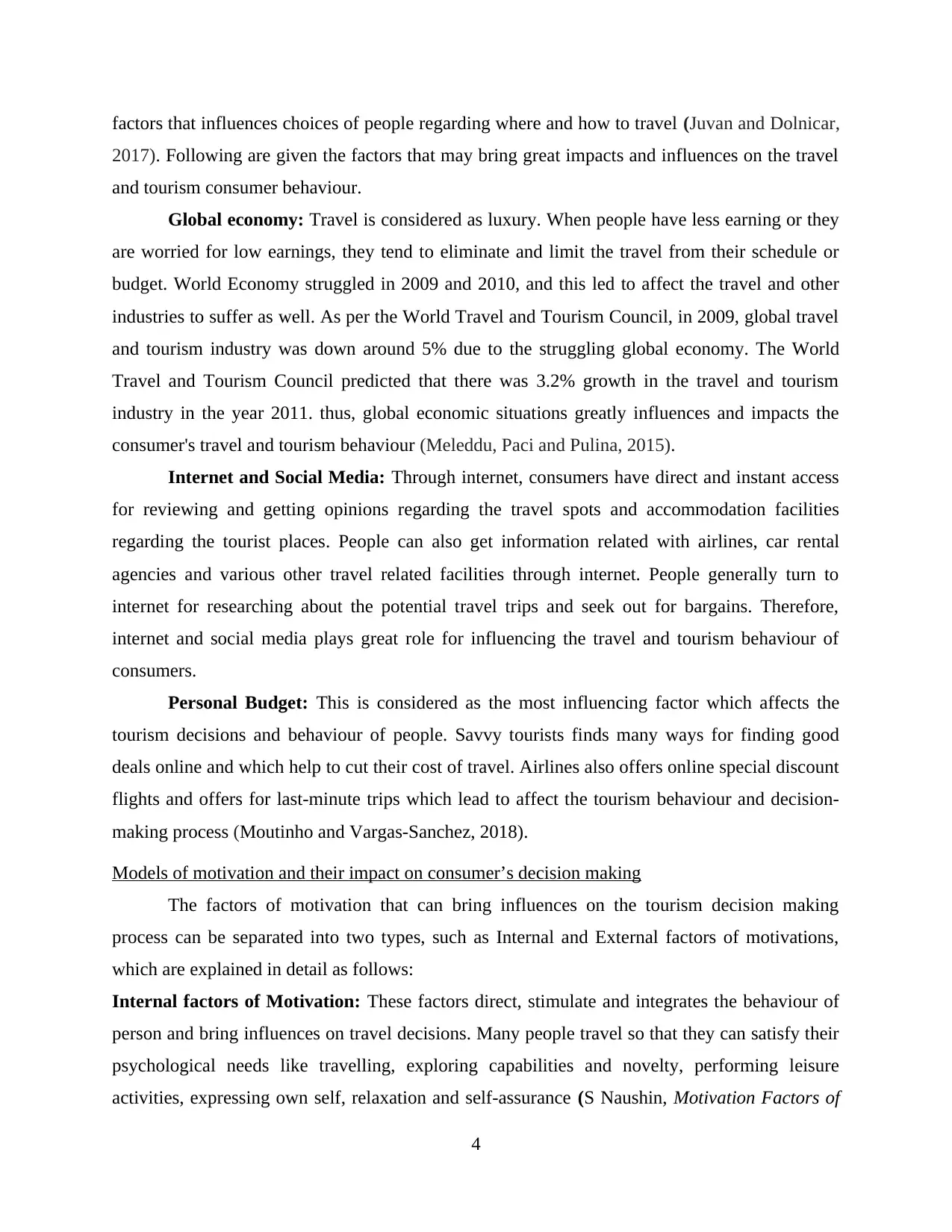
factors that influences choices of people regarding where and how to travel (Juvan and Dolnicar,
2017). Following are given the factors that may bring great impacts and influences on the travel
and tourism consumer behaviour.
Global economy: Travel is considered as luxury. When people have less earning or they
are worried for low earnings, they tend to eliminate and limit the travel from their schedule or
budget. World Economy struggled in 2009 and 2010, and this led to affect the travel and other
industries to suffer as well. As per the World Travel and Tourism Council, in 2009, global travel
and tourism industry was down around 5% due to the struggling global economy. The World
Travel and Tourism Council predicted that there was 3.2% growth in the travel and tourism
industry in the year 2011. thus, global economic situations greatly influences and impacts the
consumer's travel and tourism behaviour (Meleddu, Paci and Pulina, 2015).
Internet and Social Media: Through internet, consumers have direct and instant access
for reviewing and getting opinions regarding the travel spots and accommodation facilities
regarding the tourist places. People can also get information related with airlines, car rental
agencies and various other travel related facilities through internet. People generally turn to
internet for researching about the potential travel trips and seek out for bargains. Therefore,
internet and social media plays great role for influencing the travel and tourism behaviour of
consumers.
Personal Budget: This is considered as the most influencing factor which affects the
tourism decisions and behaviour of people. Savvy tourists finds many ways for finding good
deals online and which help to cut their cost of travel. Airlines also offers online special discount
flights and offers for last-minute trips which lead to affect the tourism behaviour and decision-
making process (Moutinho and Vargas-Sanchez, 2018).
Models of motivation and their impact on consumer’s decision making
The factors of motivation that can bring influences on the tourism decision making
process can be separated into two types, such as Internal and External factors of motivations,
which are explained in detail as follows:
Internal factors of Motivation: These factors direct, stimulate and integrates the behaviour of
person and bring influences on travel decisions. Many people travel so that they can satisfy their
psychological needs like travelling, exploring capabilities and novelty, performing leisure
activities, expressing own self, relaxation and self-assurance (S Naushin, Motivation Factors of
4
2017). Following are given the factors that may bring great impacts and influences on the travel
and tourism consumer behaviour.
Global economy: Travel is considered as luxury. When people have less earning or they
are worried for low earnings, they tend to eliminate and limit the travel from their schedule or
budget. World Economy struggled in 2009 and 2010, and this led to affect the travel and other
industries to suffer as well. As per the World Travel and Tourism Council, in 2009, global travel
and tourism industry was down around 5% due to the struggling global economy. The World
Travel and Tourism Council predicted that there was 3.2% growth in the travel and tourism
industry in the year 2011. thus, global economic situations greatly influences and impacts the
consumer's travel and tourism behaviour (Meleddu, Paci and Pulina, 2015).
Internet and Social Media: Through internet, consumers have direct and instant access
for reviewing and getting opinions regarding the travel spots and accommodation facilities
regarding the tourist places. People can also get information related with airlines, car rental
agencies and various other travel related facilities through internet. People generally turn to
internet for researching about the potential travel trips and seek out for bargains. Therefore,
internet and social media plays great role for influencing the travel and tourism behaviour of
consumers.
Personal Budget: This is considered as the most influencing factor which affects the
tourism decisions and behaviour of people. Savvy tourists finds many ways for finding good
deals online and which help to cut their cost of travel. Airlines also offers online special discount
flights and offers for last-minute trips which lead to affect the tourism behaviour and decision-
making process (Moutinho and Vargas-Sanchez, 2018).
Models of motivation and their impact on consumer’s decision making
The factors of motivation that can bring influences on the tourism decision making
process can be separated into two types, such as Internal and External factors of motivations,
which are explained in detail as follows:
Internal factors of Motivation: These factors direct, stimulate and integrates the behaviour of
person and bring influences on travel decisions. Many people travel so that they can satisfy their
psychological needs like travelling, exploring capabilities and novelty, performing leisure
activities, expressing own self, relaxation and self-assurance (S Naushin, Motivation Factors of
4
Paraphrase This Document
Need a fresh take? Get an instant paraphrase of this document with our AI Paraphraser
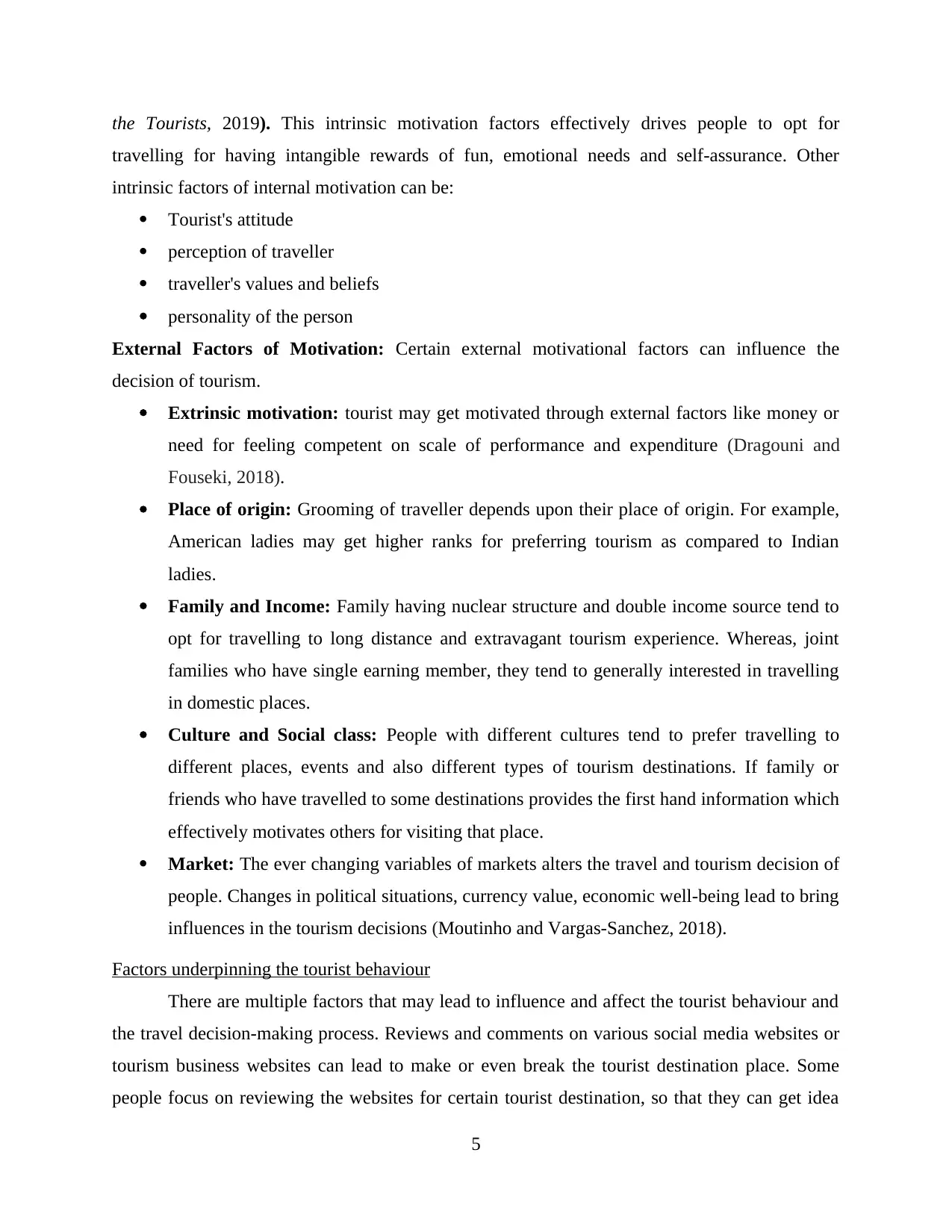
the Tourists, 2019). This intrinsic motivation factors effectively drives people to opt for
travelling for having intangible rewards of fun, emotional needs and self-assurance. Other
intrinsic factors of internal motivation can be:
Tourist's attitude
perception of traveller
traveller's values and beliefs
personality of the person
External Factors of Motivation: Certain external motivational factors can influence the
decision of tourism.
Extrinsic motivation: tourist may get motivated through external factors like money or
need for feeling competent on scale of performance and expenditure (Dragouni and
Fouseki, 2018).
Place of origin: Grooming of traveller depends upon their place of origin. For example,
American ladies may get higher ranks for preferring tourism as compared to Indian
ladies.
Family and Income: Family having nuclear structure and double income source tend to
opt for travelling to long distance and extravagant tourism experience. Whereas, joint
families who have single earning member, they tend to generally interested in travelling
in domestic places.
Culture and Social class: People with different cultures tend to prefer travelling to
different places, events and also different types of tourism destinations. If family or
friends who have travelled to some destinations provides the first hand information which
effectively motivates others for visiting that place.
Market: The ever changing variables of markets alters the travel and tourism decision of
people. Changes in political situations, currency value, economic well-being lead to bring
influences in the tourism decisions (Moutinho and Vargas-Sanchez, 2018).
Factors underpinning the tourist behaviour
There are multiple factors that may lead to influence and affect the tourist behaviour and
the travel decision-making process. Reviews and comments on various social media websites or
tourism business websites can lead to make or even break the tourist destination place. Some
people focus on reviewing the websites for certain tourist destination, so that they can get idea
5
travelling for having intangible rewards of fun, emotional needs and self-assurance. Other
intrinsic factors of internal motivation can be:
Tourist's attitude
perception of traveller
traveller's values and beliefs
personality of the person
External Factors of Motivation: Certain external motivational factors can influence the
decision of tourism.
Extrinsic motivation: tourist may get motivated through external factors like money or
need for feeling competent on scale of performance and expenditure (Dragouni and
Fouseki, 2018).
Place of origin: Grooming of traveller depends upon their place of origin. For example,
American ladies may get higher ranks for preferring tourism as compared to Indian
ladies.
Family and Income: Family having nuclear structure and double income source tend to
opt for travelling to long distance and extravagant tourism experience. Whereas, joint
families who have single earning member, they tend to generally interested in travelling
in domestic places.
Culture and Social class: People with different cultures tend to prefer travelling to
different places, events and also different types of tourism destinations. If family or
friends who have travelled to some destinations provides the first hand information which
effectively motivates others for visiting that place.
Market: The ever changing variables of markets alters the travel and tourism decision of
people. Changes in political situations, currency value, economic well-being lead to bring
influences in the tourism decisions (Moutinho and Vargas-Sanchez, 2018).
Factors underpinning the tourist behaviour
There are multiple factors that may lead to influence and affect the tourist behaviour and
the travel decision-making process. Reviews and comments on various social media websites or
tourism business websites can lead to make or even break the tourist destination place. Some
people focus on reviewing the websites for certain tourist destination, so that they can get idea
5
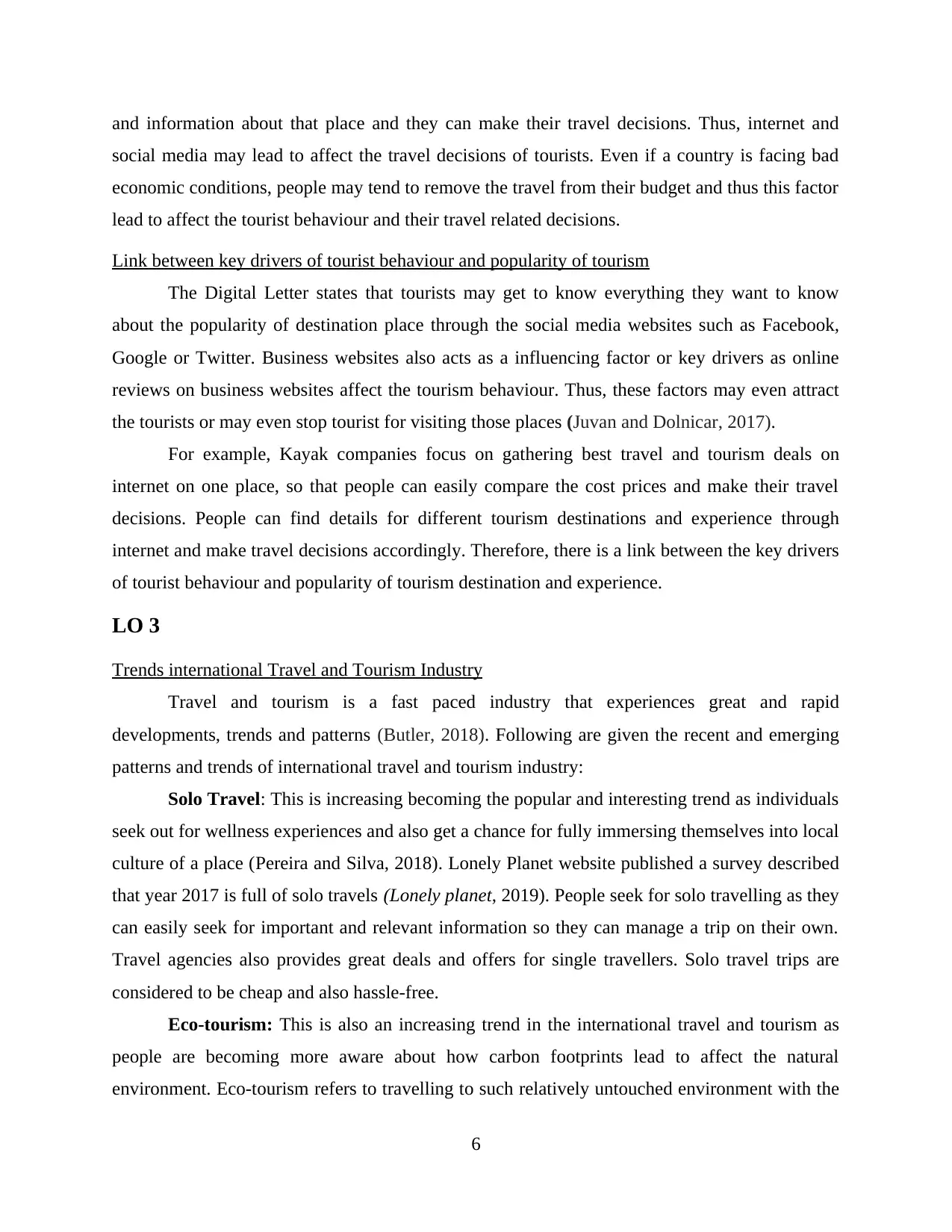
and information about that place and they can make their travel decisions. Thus, internet and
social media may lead to affect the travel decisions of tourists. Even if a country is facing bad
economic conditions, people may tend to remove the travel from their budget and thus this factor
lead to affect the tourist behaviour and their travel related decisions.
Link between key drivers of tourist behaviour and popularity of tourism
The Digital Letter states that tourists may get to know everything they want to know
about the popularity of destination place through the social media websites such as Facebook,
Google or Twitter. Business websites also acts as a influencing factor or key drivers as online
reviews on business websites affect the tourism behaviour. Thus, these factors may even attract
the tourists or may even stop tourist for visiting those places (Juvan and Dolnicar, 2017).
For example, Kayak companies focus on gathering best travel and tourism deals on
internet on one place, so that people can easily compare the cost prices and make their travel
decisions. People can find details for different tourism destinations and experience through
internet and make travel decisions accordingly. Therefore, there is a link between the key drivers
of tourist behaviour and popularity of tourism destination and experience.
LO 3
Trends international Travel and Tourism Industry
Travel and tourism is a fast paced industry that experiences great and rapid
developments, trends and patterns (Butler, 2018). Following are given the recent and emerging
patterns and trends of international travel and tourism industry:
Solo Travel: This is increasing becoming the popular and interesting trend as individuals
seek out for wellness experiences and also get a chance for fully immersing themselves into local
culture of a place (Pereira and Silva, 2018). Lonely Planet website published a survey described
that year 2017 is full of solo travels (Lonely planet, 2019). People seek for solo travelling as they
can easily seek for important and relevant information so they can manage a trip on their own.
Travel agencies also provides great deals and offers for single travellers. Solo travel trips are
considered to be cheap and also hassle-free.
Eco-tourism: This is also an increasing trend in the international travel and tourism as
people are becoming more aware about how carbon footprints lead to affect the natural
environment. Eco-tourism refers to travelling to such relatively untouched environment with the
6
social media may lead to affect the travel decisions of tourists. Even if a country is facing bad
economic conditions, people may tend to remove the travel from their budget and thus this factor
lead to affect the tourist behaviour and their travel related decisions.
Link between key drivers of tourist behaviour and popularity of tourism
The Digital Letter states that tourists may get to know everything they want to know
about the popularity of destination place through the social media websites such as Facebook,
Google or Twitter. Business websites also acts as a influencing factor or key drivers as online
reviews on business websites affect the tourism behaviour. Thus, these factors may even attract
the tourists or may even stop tourist for visiting those places (Juvan and Dolnicar, 2017).
For example, Kayak companies focus on gathering best travel and tourism deals on
internet on one place, so that people can easily compare the cost prices and make their travel
decisions. People can find details for different tourism destinations and experience through
internet and make travel decisions accordingly. Therefore, there is a link between the key drivers
of tourist behaviour and popularity of tourism destination and experience.
LO 3
Trends international Travel and Tourism Industry
Travel and tourism is a fast paced industry that experiences great and rapid
developments, trends and patterns (Butler, 2018). Following are given the recent and emerging
patterns and trends of international travel and tourism industry:
Solo Travel: This is increasing becoming the popular and interesting trend as individuals
seek out for wellness experiences and also get a chance for fully immersing themselves into local
culture of a place (Pereira and Silva, 2018). Lonely Planet website published a survey described
that year 2017 is full of solo travels (Lonely planet, 2019). People seek for solo travelling as they
can easily seek for important and relevant information so they can manage a trip on their own.
Travel agencies also provides great deals and offers for single travellers. Solo travel trips are
considered to be cheap and also hassle-free.
Eco-tourism: This is also an increasing trend in the international travel and tourism as
people are becoming more aware about how carbon footprints lead to affect the natural
environment. Eco-tourism refers to travelling to such relatively untouched environment with the
6
⊘ This is a preview!⊘
Do you want full access?
Subscribe today to unlock all pages.

Trusted by 1+ million students worldwide
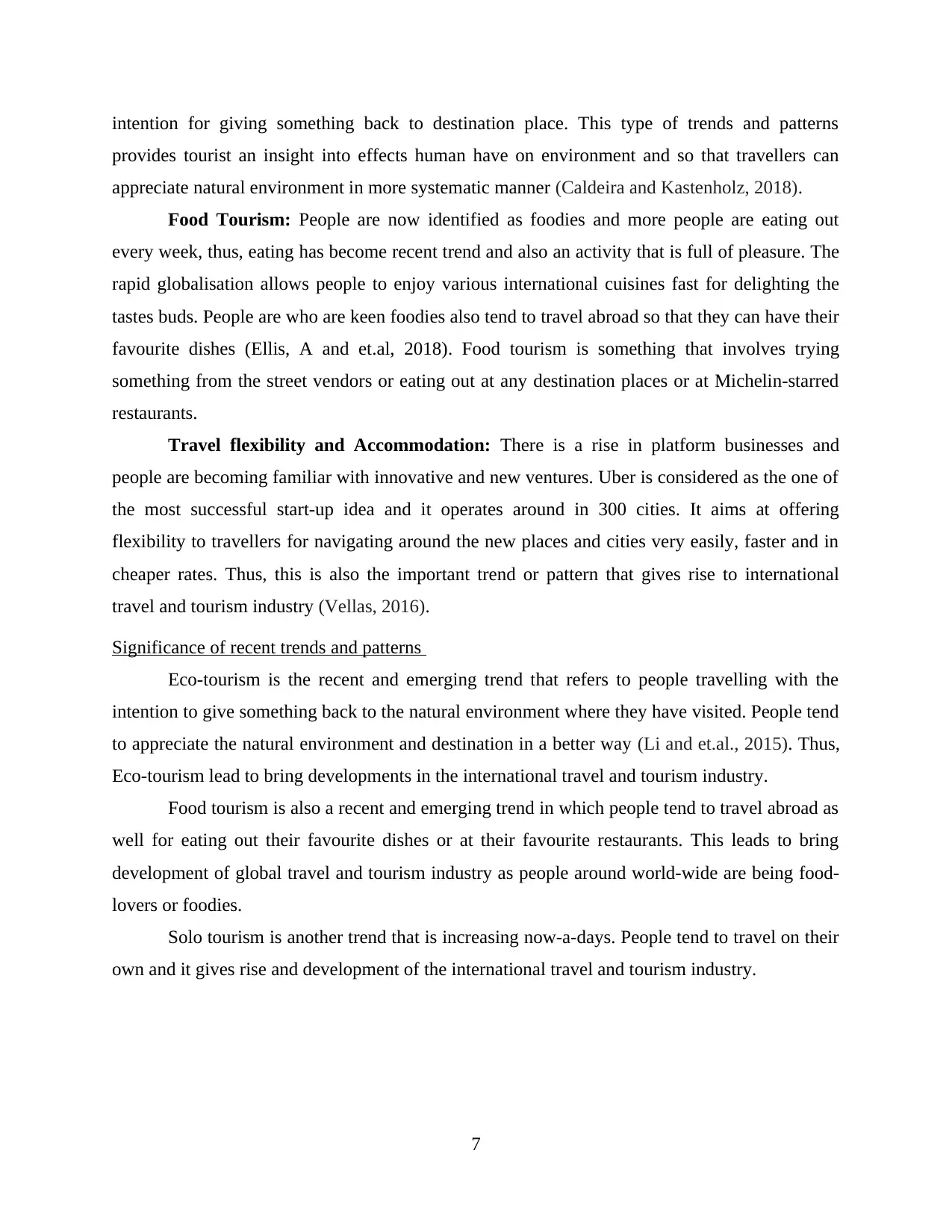
intention for giving something back to destination place. This type of trends and patterns
provides tourist an insight into effects human have on environment and so that travellers can
appreciate natural environment in more systematic manner (Caldeira and Kastenholz, 2018).
Food Tourism: People are now identified as foodies and more people are eating out
every week, thus, eating has become recent trend and also an activity that is full of pleasure. The
rapid globalisation allows people to enjoy various international cuisines fast for delighting the
tastes buds. People are who are keen foodies also tend to travel abroad so that they can have their
favourite dishes (Ellis, A and et.al, 2018). Food tourism is something that involves trying
something from the street vendors or eating out at any destination places or at Michelin-starred
restaurants.
Travel flexibility and Accommodation: There is a rise in platform businesses and
people are becoming familiar with innovative and new ventures. Uber is considered as the one of
the most successful start-up idea and it operates around in 300 cities. It aims at offering
flexibility to travellers for navigating around the new places and cities very easily, faster and in
cheaper rates. Thus, this is also the important trend or pattern that gives rise to international
travel and tourism industry (Vellas, 2016).
Significance of recent trends and patterns
Eco-tourism is the recent and emerging trend that refers to people travelling with the
intention to give something back to the natural environment where they have visited. People tend
to appreciate the natural environment and destination in a better way (Li and et.al., 2015). Thus,
Eco-tourism lead to bring developments in the international travel and tourism industry.
Food tourism is also a recent and emerging trend in which people tend to travel abroad as
well for eating out their favourite dishes or at their favourite restaurants. This leads to bring
development of global travel and tourism industry as people around world-wide are being food-
lovers or foodies.
Solo tourism is another trend that is increasing now-a-days. People tend to travel on their
own and it gives rise and development of the international travel and tourism industry.
7
provides tourist an insight into effects human have on environment and so that travellers can
appreciate natural environment in more systematic manner (Caldeira and Kastenholz, 2018).
Food Tourism: People are now identified as foodies and more people are eating out
every week, thus, eating has become recent trend and also an activity that is full of pleasure. The
rapid globalisation allows people to enjoy various international cuisines fast for delighting the
tastes buds. People are who are keen foodies also tend to travel abroad so that they can have their
favourite dishes (Ellis, A and et.al, 2018). Food tourism is something that involves trying
something from the street vendors or eating out at any destination places or at Michelin-starred
restaurants.
Travel flexibility and Accommodation: There is a rise in platform businesses and
people are becoming familiar with innovative and new ventures. Uber is considered as the one of
the most successful start-up idea and it operates around in 300 cities. It aims at offering
flexibility to travellers for navigating around the new places and cities very easily, faster and in
cheaper rates. Thus, this is also the important trend or pattern that gives rise to international
travel and tourism industry (Vellas, 2016).
Significance of recent trends and patterns
Eco-tourism is the recent and emerging trend that refers to people travelling with the
intention to give something back to the natural environment where they have visited. People tend
to appreciate the natural environment and destination in a better way (Li and et.al., 2015). Thus,
Eco-tourism lead to bring developments in the international travel and tourism industry.
Food tourism is also a recent and emerging trend in which people tend to travel abroad as
well for eating out their favourite dishes or at their favourite restaurants. This leads to bring
development of global travel and tourism industry as people around world-wide are being food-
lovers or foodies.
Solo tourism is another trend that is increasing now-a-days. People tend to travel on their
own and it gives rise and development of the international travel and tourism industry.
7
Paraphrase This Document
Need a fresh take? Get an instant paraphrase of this document with our AI Paraphraser
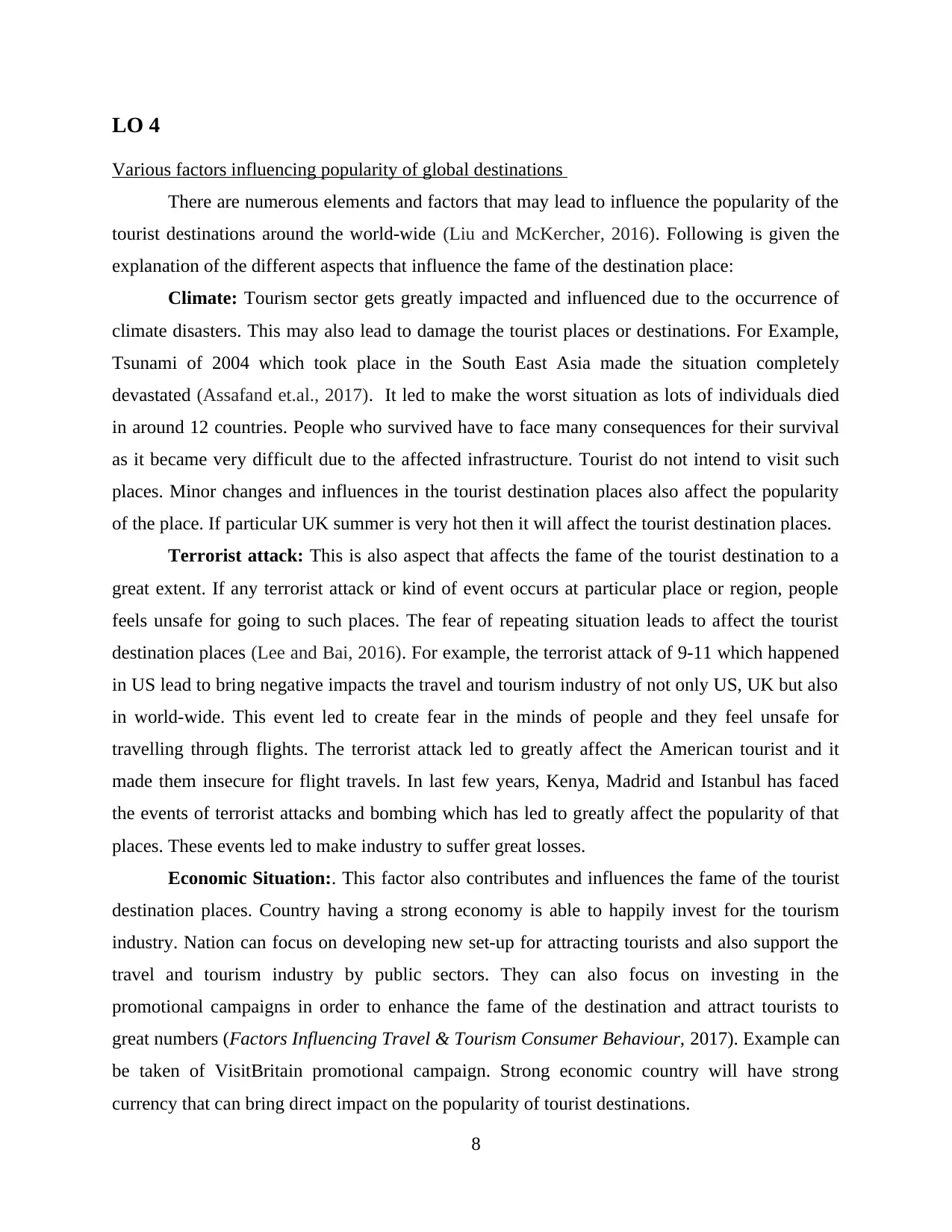
LO 4
Various factors influencing popularity of global destinations
There are numerous elements and factors that may lead to influence the popularity of the
tourist destinations around the world-wide (Liu and McKercher, 2016). Following is given the
explanation of the different aspects that influence the fame of the destination place:
Climate: Tourism sector gets greatly impacted and influenced due to the occurrence of
climate disasters. This may also lead to damage the tourist places or destinations. For Example,
Tsunami of 2004 which took place in the South East Asia made the situation completely
devastated (Assafand et.al., 2017). It led to make the worst situation as lots of individuals died
in around 12 countries. People who survived have to face many consequences for their survival
as it became very difficult due to the affected infrastructure. Tourist do not intend to visit such
places. Minor changes and influences in the tourist destination places also affect the popularity
of the place. If particular UK summer is very hot then it will affect the tourist destination places.
Terrorist attack: This is also aspect that affects the fame of the tourist destination to a
great extent. If any terrorist attack or kind of event occurs at particular place or region, people
feels unsafe for going to such places. The fear of repeating situation leads to affect the tourist
destination places (Lee and Bai, 2016). For example, the terrorist attack of 9-11 which happened
in US lead to bring negative impacts the travel and tourism industry of not only US, UK but also
in world-wide. This event led to create fear in the minds of people and they feel unsafe for
travelling through flights. The terrorist attack led to greatly affect the American tourist and it
made them insecure for flight travels. In last few years, Kenya, Madrid and Istanbul has faced
the events of terrorist attacks and bombing which has led to greatly affect the popularity of that
places. These events led to make industry to suffer great losses.
Economic Situation:. This factor also contributes and influences the fame of the tourist
destination places. Country having a strong economy is able to happily invest for the tourism
industry. Nation can focus on developing new set-up for attracting tourists and also support the
travel and tourism industry by public sectors. They can also focus on investing in the
promotional campaigns in order to enhance the fame of the destination and attract tourists to
great numbers (Factors Influencing Travel & Tourism Consumer Behaviour, 2017). Example can
be taken of VisitBritain promotional campaign. Strong economic country will have strong
currency that can bring direct impact on the popularity of tourist destinations.
8
Various factors influencing popularity of global destinations
There are numerous elements and factors that may lead to influence the popularity of the
tourist destinations around the world-wide (Liu and McKercher, 2016). Following is given the
explanation of the different aspects that influence the fame of the destination place:
Climate: Tourism sector gets greatly impacted and influenced due to the occurrence of
climate disasters. This may also lead to damage the tourist places or destinations. For Example,
Tsunami of 2004 which took place in the South East Asia made the situation completely
devastated (Assafand et.al., 2017). It led to make the worst situation as lots of individuals died
in around 12 countries. People who survived have to face many consequences for their survival
as it became very difficult due to the affected infrastructure. Tourist do not intend to visit such
places. Minor changes and influences in the tourist destination places also affect the popularity
of the place. If particular UK summer is very hot then it will affect the tourist destination places.
Terrorist attack: This is also aspect that affects the fame of the tourist destination to a
great extent. If any terrorist attack or kind of event occurs at particular place or region, people
feels unsafe for going to such places. The fear of repeating situation leads to affect the tourist
destination places (Lee and Bai, 2016). For example, the terrorist attack of 9-11 which happened
in US lead to bring negative impacts the travel and tourism industry of not only US, UK but also
in world-wide. This event led to create fear in the minds of people and they feel unsafe for
travelling through flights. The terrorist attack led to greatly affect the American tourist and it
made them insecure for flight travels. In last few years, Kenya, Madrid and Istanbul has faced
the events of terrorist attacks and bombing which has led to greatly affect the popularity of that
places. These events led to make industry to suffer great losses.
Economic Situation:. This factor also contributes and influences the fame of the tourist
destination places. Country having a strong economy is able to happily invest for the tourism
industry. Nation can focus on developing new set-up for attracting tourists and also support the
travel and tourism industry by public sectors. They can also focus on investing in the
promotional campaigns in order to enhance the fame of the destination and attract tourists to
great numbers (Factors Influencing Travel & Tourism Consumer Behaviour, 2017). Example can
be taken of VisitBritain promotional campaign. Strong economic country will have strong
currency that can bring direct impact on the popularity of tourist destinations.
8
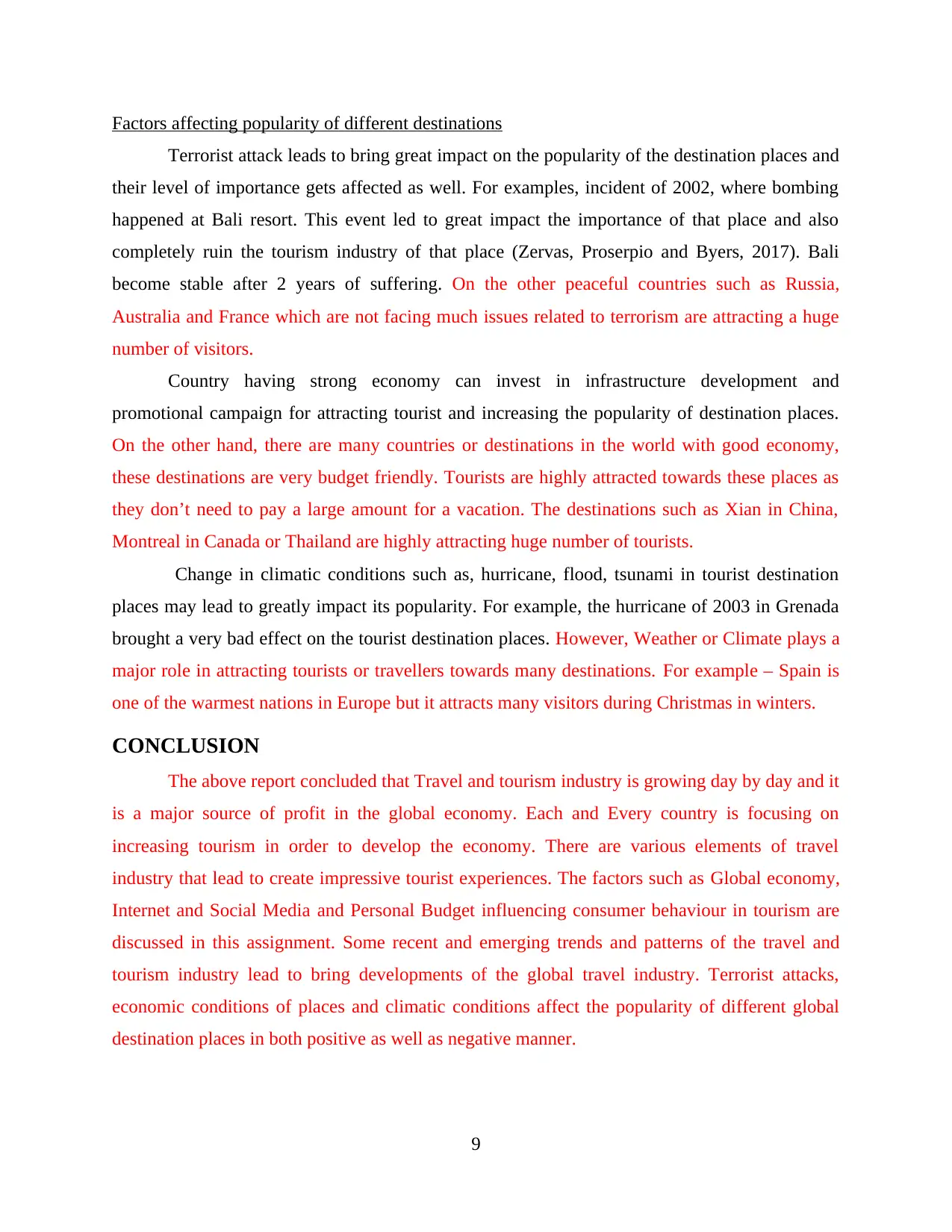
Factors affecting popularity of different destinations
Terrorist attack leads to bring great impact on the popularity of the destination places and
their level of importance gets affected as well. For examples, incident of 2002, where bombing
happened at Bali resort. This event led to great impact the importance of that place and also
completely ruin the tourism industry of that place (Zervas, Proserpio and Byers, 2017). Bali
become stable after 2 years of suffering. On the other peaceful countries such as Russia,
Australia and France which are not facing much issues related to terrorism are attracting a huge
number of visitors.
Country having strong economy can invest in infrastructure development and
promotional campaign for attracting tourist and increasing the popularity of destination places.
On the other hand, there are many countries or destinations in the world with good economy,
these destinations are very budget friendly. Tourists are highly attracted towards these places as
they don’t need to pay a large amount for a vacation. The destinations such as Xian in China,
Montreal in Canada or Thailand are highly attracting huge number of tourists.
Change in climatic conditions such as, hurricane, flood, tsunami in tourist destination
places may lead to greatly impact its popularity. For example, the hurricane of 2003 in Grenada
brought a very bad effect on the tourist destination places. However, Weather or Climate plays a
major role in attracting tourists or travellers towards many destinations. For example – Spain is
one of the warmest nations in Europe but it attracts many visitors during Christmas in winters.
CONCLUSION
The above report concluded that Travel and tourism industry is growing day by day and it
is a major source of profit in the global economy. Each and Every country is focusing on
increasing tourism in order to develop the economy. There are various elements of travel
industry that lead to create impressive tourist experiences. The factors such as Global economy,
Internet and Social Media and Personal Budget influencing consumer behaviour in tourism are
discussed in this assignment. Some recent and emerging trends and patterns of the travel and
tourism industry lead to bring developments of the global travel industry. Terrorist attacks,
economic conditions of places and climatic conditions affect the popularity of different global
destination places in both positive as well as negative manner.
9
Terrorist attack leads to bring great impact on the popularity of the destination places and
their level of importance gets affected as well. For examples, incident of 2002, where bombing
happened at Bali resort. This event led to great impact the importance of that place and also
completely ruin the tourism industry of that place (Zervas, Proserpio and Byers, 2017). Bali
become stable after 2 years of suffering. On the other peaceful countries such as Russia,
Australia and France which are not facing much issues related to terrorism are attracting a huge
number of visitors.
Country having strong economy can invest in infrastructure development and
promotional campaign for attracting tourist and increasing the popularity of destination places.
On the other hand, there are many countries or destinations in the world with good economy,
these destinations are very budget friendly. Tourists are highly attracted towards these places as
they don’t need to pay a large amount for a vacation. The destinations such as Xian in China,
Montreal in Canada or Thailand are highly attracting huge number of tourists.
Change in climatic conditions such as, hurricane, flood, tsunami in tourist destination
places may lead to greatly impact its popularity. For example, the hurricane of 2003 in Grenada
brought a very bad effect on the tourist destination places. However, Weather or Climate plays a
major role in attracting tourists or travellers towards many destinations. For example – Spain is
one of the warmest nations in Europe but it attracts many visitors during Christmas in winters.
CONCLUSION
The above report concluded that Travel and tourism industry is growing day by day and it
is a major source of profit in the global economy. Each and Every country is focusing on
increasing tourism in order to develop the economy. There are various elements of travel
industry that lead to create impressive tourist experiences. The factors such as Global economy,
Internet and Social Media and Personal Budget influencing consumer behaviour in tourism are
discussed in this assignment. Some recent and emerging trends and patterns of the travel and
tourism industry lead to bring developments of the global travel industry. Terrorist attacks,
economic conditions of places and climatic conditions affect the popularity of different global
destination places in both positive as well as negative manner.
9
⊘ This is a preview!⊘
Do you want full access?
Subscribe today to unlock all pages.

Trusted by 1+ million students worldwide
1 out of 14
Related Documents
Your All-in-One AI-Powered Toolkit for Academic Success.
+13062052269
info@desklib.com
Available 24*7 on WhatsApp / Email
![[object Object]](/_next/static/media/star-bottom.7253800d.svg)
Unlock your academic potential
Copyright © 2020–2025 A2Z Services. All Rights Reserved. Developed and managed by ZUCOL.




